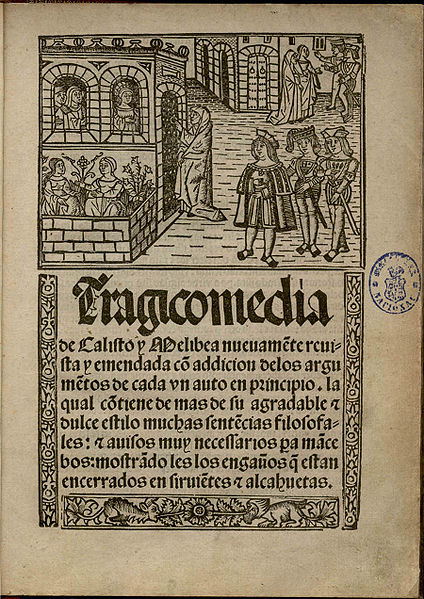Want to know a little bit more about La Celestina before you come to see the show? You can read a bilingual version of the original novel online or peruse our synopsis of the original novel below. This is an excerpt from our complimentary study guide, which you can download in PDF format in English or en español.
Calisto, a middle-class young nobleman enters the garden of Pleborio while searching for his falcon. When he sees Melibea, the daughter of Pleborio and Alisa, he falls madly in love with her. Faced with Melibea’s rejections, he seeks advice from his corrupt servant Sempronio, who advises him to meet with Celestina, a former prostitute and procuress, wise in the ways of romance. Calisto’s other servant Pármeno warns him of the dangers of dealing with Celestina, but Calisto ignores his warnings. Pármeno knows firsthand about Celestina; he has been vulnerable to her promises of meeting with her protégée Areusa, whom he loves.
Calisto meets with Celestina and she agrees to help him. She pays a visit Melibea and her mother Alisa and convinces Melibea that Calisto is suffering from a toothache and that only Melibea can help relieve it. On this premise, Celestina obtains a waistband and the promise of a letter from Melibea. Meanwhile, Sempronio and Pármeno see an economic advantage of working together, so they agree to help Celestina to get as much from their master as possible by convincing him that she needs more support in order to win Melibea for him.
Melibea is soon overcome by a strange illness and calls upon Celestina to diagnose and cure her. Celestina tells her the cure is to meet Calisto in person and she promises to set up this meeting. The two meet in Melibea’s garden and, as payment, Calisto gives Celestina the gift of gold chain. However, Pármeno interrupts the meeting with a warning that someone is coming (in order to necessitate a next meeting which Celestina will again have to negotiate and again, be repaid).
Pármeno and Sempronio return to Celestina’s house to get their share of the gold chain, but she will not give it over, and they murder her. When they try to escape, they are caught and executed. Calisto is unfazed by the death of his servants and on the next night, he returns to Melibea’s garden with a ladder to climb the walls to reach her. However, after finally seducing Melibea, he tragically falls to his death while trying to escape down the ladder. Melibea, overcome by grief, confesses her love for Calisto to her father and then commits suicide by jumping from the garden tower.
The original work written by Fernando de Rojas consists of 21 acts and the adaptation by Raquel Carrió is a condensed version with 16 acts. In the adapted version, several scenes and characters are omitted. In the original, the first scene with Calisto and Melibea in the garden is represented, but only a tableau hints at Calisto and Melibea’s relationship in the adapted version. Fernando de Rojas also employs more imagery in his description of Melibea. He compares her hair to Arabian golden thread and from his description we learn that she has long hair, green eyes, long eyelashes, thin, arched eyebrows, a medium sized nose, small lips, and skin lighter than snow. These physical traits match more with the Renaissance standard of beauty more than Carrió’s description of “golden locks” and “skin like pearl.” Carrió’s version also omits the character of Pármeno, who tries to warn Calisto of the dangers of working with Celestina. The original version also offers more insights to psychology of Celestina’s character, the pride she takes in her work and how she can face without embarrassment anyone


